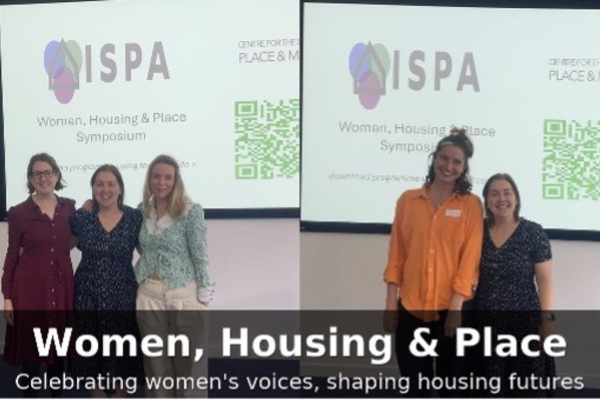

In this imagined future PhD Researcher Jenny Brierley and HSA Chair Phil Brown muse on what the world might be like in 30 years when the housing sector achieves net-zero carbon and some of the steps that are needed and could be taken to get there...
We did it! It’s 2050 and we’ve achieved what everyone thought was impossible…zero carbon emissions from the whole of UK housing. This blog looks back over the last 30 years to look at how this was made possible in the years since COP26.
Those who were there would tell us that it all started long before 2020, with mounting pressure from citizens across all walks of life, from all corners of the globe. Since the early 2000s pressure had been building from citizens, urging those in power to take the evidence seriously that climate breakdown was real. Up until 2018/19 people used to call what was happening to the planet ‘climate change’, which was a rather quaint way of describing the floods, forest fires and weather extremes that caused countless deaths and destruction to so many across the world. It was though 2020 that those in power – amongst them those in the housing sector – started to take concrete steps.
The housing sector was slow to start, especially after Business Continuity Plans were tested to the limit by the coronavirus pandemic, but momentum really picked up when a collective decision was made that the climate crisis was the number one risk facing the sector. It was a lightbulb moment and housing organisations all over the country were soon tearing up their business plans and starting again, creating a pathway to zero emissions.
Politicians soon got the message from their constituents, and all of the housing world, that ‘green talk’ was not enough; whatever they promised at COP26, it was ‘green action’ that was going to keep them in power. A new willingness to change policies emerged at the then Ministry of Housing, Communities and Local Government (MHCLG). The new Environment Act 2021 charted a set of new benchmarks. Carbon cost became the metric for investment, from new airports to housing schemes, and Homes England, funder at the time, led the way on making zero-carbon non-negotiable for new homes.
Addressing the task of 27 million existing homes was a tough challenge. But in a moment of striking leadership from all quarters the housing sector did not wait for regulation. Previous pilot and demonstrator projects soon became mainstream when funding for retrofit was unlocked. It seems unbelievable now that back in the 2020s some people working in housing still thought investment in whole-house zero-carbon retrofit was too expensive and that the net zero challenge wouldn’t impact housing to any discernible degree.
The Great British Retrofit Challenge gripped the nation in the 2020s. Tenants swept the board, creating initiatives that have shaped how we live today, cutting energy costs as well as carbon, inspiring the housing sector and politicians to be adventurous and bold in tackling the climate crisis.
Housebuilders were shocked to find that high end kitchens with built in wine chillers, coffee grinders and plate warmers, not to mention a 1:1 people to bathroom ratio no longer sold homes. New buyers wanted triple glazing, not triple garages. They soon got the message and competed with each other on how self-sufficient and frugal their homes were.
Electric charging points were everywhere by 2025, but how retro private cars now seem! Now that we enjoy ultra-fast and flexible, renewably-powered, shared transport – and clean air – our cities enjoy green spaces and are no longer planned around car parks.
By 2030 it was rare to see a roof that was not solar-connected, sparking a step-change in energy production and distribution. This was a huge change for landlords, who found they were energy managers as well as housing providers. We’re now so used to our homes being part of the energy network that people have forgotten how radical, and indeed suspicious, that seemed in 2020. We all take for granted now the flexibility that local distribution gives us, no longer using fossil fuels and well on the way to phasing out nuclear power. Of course, our homes are ultra-insulated now so we use only a fraction of the energy that our parents used back in 2020.
By the 2040s carbon emissions from our homes were among the lowest in the world, and the world was celebrating signs that climate change was at last starting to slow. In 2045 we were thrilled to win the coveted Thunberg Trophy for cutting emissions, presented by Greta herself in an on-line ceremony attended by millions, seeing off challenges from our historic rivals Scandinavia and Germany, and, of course, China, a late entrant in the race that has astounded the world with its progress in recent decades.
So who has played a part in UK housing achieving zero?
Leadership, at every level, was fundamental to moving the agenda forwards. Boards, CEOs, politicians, policymakers; held to account by tenants, communities, constituents, everyday people, all played a part.
Researchers played a critical part too. Research into low-carbon technologies, and the impact of these on householders, had been around for decades, stimulated partly by the oil crisis back in the 1970s. However, much of this work had remained in academic circles, rarely making an impact on policy-making or utilised by organisations with the power to bring about wholesale change.
But a step-change was taking place within ivory towers. Work on climate change ceased to be the sole domain of climate scientists and geographers. Social scientists, architects, building physicists and housing researchers started to come together, and a few like-minded people across academia, think-tanks and businesses started to talk about how their work was interrelated. The Housing Studies Association, now so well known, was instrumental in bringing together established and early career researchers to share and collaborate across disciplines and create new conversations with those in housing and other policy areas.
So, looking back, 2020 was a pivotal year for zero carbon housing. COP26 was the kick that the housing sector needed to stop procrastinating and start taking bold action. The pathway to zero carbon, especially for homes that existed long before we realised how quickly we were damaging the environment, has not been easy or cheap, but we’re thankful now that far-sighted practitioners, policy-makers, and researchers, working together, made that investment happen, giving us hope for the future now.
Zero housing emissions is just the start…working together with creativity, boldness, and tenacity to protect our planet does not stop in 2050!
Boldness has genius, power and magic in it
- Goethe
Jenny embarked on PhD research at Sheffield University after a long career in housing associations in Yorkshire. Her passion for sustainable housing is now directed at the ventilation of low-energy homes, exploring the experience of residents and maintenance. And Phil is HSA Chair and Professor of Housing and Communities at the University of Huddersfield. Phil’s research aims to understand and contribute to alleviating the housing inequalities experiences by members of particular marginalised communities.
The HSA is pleased to announce our co-blogs series. The co-blogs series encourages new connections between HSA members. Several HSA members, of varying levels of career, have volunteered to write blogs together on housing issues of common interest and the outputs will be published in the coming months.






